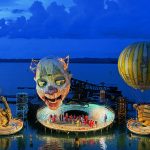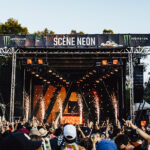It takes a lot of planning and coordination to realize the designs of some of todays’ biggest concert tours with their massive structures, complex automation and immense video walls. If you are among the supplying production companies on these tours, success is in the details and all about collaboration. A perfect example of this production reality is the incredible four-sided LED video structure, known as the Monolith, on Beyoncé’s Formation world tour. The centerpiece of Es Devlin’s production design for the tour, it is the result of a collaboration between Stageco, Tait and PRG Nocturne.

The Timeline: “Beyond Aggressive”
“The most interesting, and also challenging, bit was the level of coordination required between all of the vendors as our equipment was so heavily integrated with each other,” says Brian Levine, senior project manager with Tait. “The timeline in which we all had to produce this project was beyond aggressive, and it forced us to communicate with each other almost hourly at times. We all designed and assembled our respective parts of the project and knew it would only come together for the first time on site at the stadium in Tampa for rehearsals.”

The 180-ton monolith’s structural elements were custom-manufactured and supplied by Stageco in partnership with Belgian motion control systems provider WIcreations. It measures 22 by 16 by 9 meters in size (about 72 by 52.5 by 29.5 feet, HxWxD). Stageco also provided the 203 by 115 foot stage (62 by 35 meters, WxD), in which the monolith is embedded. The monolith sits on a circular 360° track that rotates in both directions at a speed of 200mm per second, taking about three minutes and 20 seconds to complete a full rotation.
“At 22 meters high, this incredible video box is similar in size to a small apartment building, but it also needs to rotate, and the video screen has to split into two halves at certain moments during the show, leaving a gap of around seven meters (23 feet),” says Dirk De Decker, Stageco’s international projects director. To meet both the needs for assembly and the tour schedule, Stageco built four steel systems that leapfrog each other on the road. Each requires 23 trucks. The first was erected for the rehearsals in Tampa on April 1, prior to the April 27 kick-off for the tour in Miami.

A 180-Ton Structure
Stageco’s structural engineer, Tom Frederickx notes, “Weight-wise, it’s a total of 180 tons that we are actually turning. Then we also can slide it open, splitting the left side and the right side — that’s including also the back — so at that moment, you can see completely through in the middle. To create the 23-foot gap in between the video screens, it is controlled with the motors at the bottom and the top, to slide it open. The bottom grids are basically on a wagon, and you have a track on top of it, on top of the static grid.” WIcreations’ motion control system worked along with Tait’s Navigator automation system to govern the movement of the staging elements.
The monolith is clad entirely in LED video tiles. The front and back sides are covered with WinVision 9mm AIR modules, and the SL and SR sides are covered with PRG Nocturne V18 modules. PRG Nocturne supplied 1,088 WinVision 9mm AIR LED tiles, 1,700 PRG Nocturne V18 LED tiles, 144 WinVision 12mm AIR LED tiles and the d3 Technologies d3 media server which feeds all the screens. Hoists were out-hung from the top of the structure for the video crew to skin the skeleton in increments. Strict attention to hanging points was necessary to ensure a seamless video look on the edges and corners.

Since Stageco had to order a number of items requiring long lead times before most of the project scope was defined, many weight constraints were already set before anyone even knew what the video product was going to be. “The biggest challenge we all faced was the weight limits,” explains Dustin King, project manager, PRG Nocturne. “During our first production meetings, we were tasked with finding an LED product that fit within the allowance of the wheels under the stage. We had to put our focus into providing a product that was not just lightweight but which also had a lightweight framework and was capable of hanging 60 feet high.”

Tait worked closely with both Stageco and PRG Nocturne to mount all of the LED video modules onto the structure. And if the rotating and video-splitting mechanics weren’t challenging enough, the design also called for automated doors to be embedded within the LED screens.
“To maintain pixel pitch of the 18mm and 9mm LED, these doors have extremely tight tolerances, which made fabrication very challenging,” Levine explains. “The doors are pneumatically and electrically actuated, all controlled via Tait Navigator, our proprietary automation software system. To allow the doors to be built at the same time as the LED walls, we fabricated custom LED frames to match the pitch, and also to fit into the carts of the PRG Nocturne existing frame system. Heavy duty custom-made tracks clip to the back of the walls to help guide the doors as they open and close during the show.”
The biggest reward for all the vendors was perhaps hearing the crowd’s enthusiastic reaction as the monolith came to life during the first show in Miami. The Formation tour treks through North American until the June 14 show in Detroit, then picks up in the U.K. and Europe on June 28. After an Aug. 3 show in Barcelona, the tour returns to the U.S., with shows set from Sept. 7 to Oct. 2.


